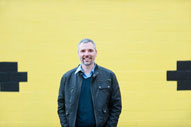
Metro Detroit recently landed a $2.85 million Sustainable Communities grant to help the region become more dense and develop its transit options. Brad Garmon, land programs director at the Michigan Environmental Council, offers a free-thinking approach to connecting the historically disparate forces of housing, land use, and eco-consciousness.
Post 5: Culture or Infrastructure?
Posted By: Brad Garmon
Posted: 12/7/2010
So, here's a simple question my wife asked me: Who do you hope reads this? Who could make the changes you're suggesting?
The people I most hope read this are the people making decisions about what we are going to build next: transit systems, electrical grids, water and sewer systems, bike lanes, sidewalks, roads. It boils down to infrastructure.
But who is that, exactly?
Decisions made locally – lots of low-density, auto-dependent malls, housing developments, office and industrial parks – push regional transportation planners to add more highway lane miles and pave more rural roads to provide mobility.
In turn, the willingness of regional transportation planners to build those bigger, wider roads encourages locals to allow more low-density auto-dependent development.
Michigan is just wrapping up a road widening on a five mile stretch of M-59 highway in Oakland County – going from four lanes to six lanes – that cost around $50 million. That's about $10 million per mile.
Was it the best use of the money? For some people, maybe. For the region as a whole? No.
Which brings me back to the two most important pieces of the new Sustainable Communities regional planning grant: first, we need a shared, regional vision – fewer plans, and plans that have more buy-in from more people across all walks of life in Metro Detroit. Second, we need to give our infrastructure planners a shorter list of priority investments and projects that everyone believes in.
Two visions are worth taking a look at in that regard.
First, SEMCOG's Sustainable regional planning grant was preceded by SEMCOG's Framework for Sustainability in Southeast Michigan, adopted by the group's executive committee in May 2010. It gives some indication of issues that need to be addressed, including transit investments, infrastructure limitations and local planning coordination.
That document recognizes that we will only prosper if we have a common regional vision for future infrastructure decisions. It's not just about lane miles; it's about transit projects, including Woodward Light Rail, Detroit to Ann Arbor commuter rail, and a line from Washtenaw to Livingston County.
Second, the Michigan Environmental Council (MEC), where I work, has a first-draft vision of what we'd like Michigan to look like in 50 years. It includes proposals for our great cities, for policies to help build more sustainable communities, and strategies for transportation and protection of our Great Lakes assets.
MEC has also spent the last year hosting meetings all across the state to listen to people's vision for a future Michigan connected as it once was – by affordable, fast and convenient rail.
For me personally, this all starts with transportation.
We need a new regional plan that starts with a realistic look at transportation in all its facets – its relationship to residents and neighborhoods, what modes make sense going forward, and how to pay for the maintenance of all those lane-miles and bridges we spent the last 60 years building.
There is a fundamental shift that needs to take place. We need a new conception of transportation specifically and infrastructure generally.
Rather than being designed simply to move lots of cars or water or electrons, infrastructure needs to be re-envisioned as the basic building blocks of community – it underlies our basic health and our regional economy; it connects us to education and neighborhood life; it offers us access to each other and the wider world.
Part of SEMCOG's sustainable communities program, as it stands today, is directed at "culture change", an education and outreach program predicated on the notion that in order to create sustainable communities they first have to convince people that they should want them.
I have my doubts about the necessity of this.
There will always be people who want to live in rural areas, or on a lake in Oakland County. We won't have to change their minds and we shouldn't try.
What we can do in the coming decades is build communities connected internally by regional transit. Neighborhoods designed around those transit hubs, with residential density and jobs. Mixed use neighborhoods with grocery stores and parks and schools right around the corner, accessible by foot or bicycle.
The shift to sustainable communities isn't something that has to take place in our heads. It needs to take place on the landscape.